Cultural Analysis, Volume 6, 2007
Burgundian Regionalism and French Republican Commercial Culture at the 1937 Paris International Exposition
Abstract: This article discusses how early twentieth-century France developed rustic modernization projects anchored in traditional regional practices. This entailed overcoming political and cultural fears associated with regional allegiances as well as developing regional cultural agendas susceptible to economic exploitation. The case study of how Burgundians marketed artisan workmanship, gastronomical traditions, vernacular architecture, and folkloric traditions at the 1937 Paris International Exposition illustrates how a commercial paradigm of French national identity was rooted in provincial productivity.
____________________
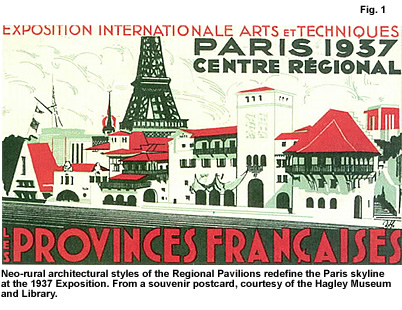
Introduction: The Problem with Rural France
One must visit its provinces to truly understand France. Only there … are the nation's particularities unveiled.
–Stefan Zweig, Voyages [1931]
Moralists, pundits and scholars have anchored their interpretations of French history in the putative virtues and alleged deficiencies of France's agrarian traditions and agricultural structures (Duby and Wallon 1976; Pitte 1983; Agulhon 1988; Antoine 1999; Le Roy Ladurie 1974; Le Roy Ladurie 2001; Moriceau 2002). Herman Lebovics characterizes conventional discourses about the nature or identity of "true France" as inherently reactionary insofar as they generally employ "political-theological nonsense" to maintain "that there can be only one way to participate in the culture of a country and only one natural political organization that fits society" (1992, xiv and xiii). Stéphane Gerson's argues that the concept of "local France" has "long evoked a story of neglect, coercion, nostalgia, and reaction" (2003, 539). Many still imagine rural France as the source of reactionary political and social agendas. The problem with such interpretations, anchored in depictions of the French Revolution's counter-revolutionary enemies to the Revolution Nationale's crypto-fascist supporters, is that they frequently either dismiss or undervalue the diversity and modernity of cultural formations originating in the French provinces.
This view has been challenged recently. Thiébaut Flory characterizes early twentieth-century French regionalism as a "rich and multi-faceted ideology that seem[ed] to reconcile the most contradictory doctrines and still offered a certain unity of thought" (1992, 42). Patrick Young adds that "regionalism lent itself to a range of inflections, many informed by the desire to consciously avoid the charged polarities of French Politics" (2002, 171). Shanny Peer shows how folk representations of "rural France" were endorsed and exploited by France's leftist Popular Front government at the 1937 Paris International Exposition (1998). Supporting these interpretations, this article examines the Burgundian presence at the 1937 Paris International Exposition in order to better understand the nature and significance of regional contributions to the French modernization project during the Interwar years.
Consistent with interpretations that emphasize the importance of regional and rural agendas from France's Third Republic through Vichy's National Revolution and into the late twentieth century, my analysis of Burgundian regionalism examines how resuscitated or newly created "traditions" served to link regional interests to a French national political identity (Faure 1989). Although some scholars might argue that the resurgence of French regionalism "was only and gradually reintroduced under the condition that it became presentable in republican eyes" (den Boer, 47), I maintain that regionalism resulted from the regionalists' own ability to influence the terms and conditions under which regional cultural and economic practices were politically recognized, especially during the interwar years.
French Modernization and Burgundian Regionalism
The point is that politics is social, not textual, and if the text is made political, its politicization is effected at its point of entry into the social.… If the political potential of a text is to be mobilized, the text must reproduce among the discourses that comprise it a struggle equivalent to that experienced socially by its readers.
–John Fiske, Understanding Popular Culture (1989, 168).
Eric Hobsbawm has described modern Europe as period of rapid change resulting in a search for "new social devices to ensure or express social cohesion and identity and to structure social relationships" (1983; 1990). This analysis has a particular salience for Interwar Burgundy. Interwar Burgundians consciously exploited folk images and rural idioms to articulate an idealized, mystifying, and reassuring regional model of French modernity (Poirrier 1995; Bazin 1996 and 1997; Whalen 1999; Laferté 2002; Whalen 2007b). This strategy of ideological implication (White, 1987) used rustic referents of a "collective dream-world" (Buck-Morse 1989, 71) or imagined community (Hobsbawm 1983; Anderson 1991; Jameson 1992; Moentmann 2003) to animate residual social values, palliate cultural anxieties, mobilize political interests, and market regional products into what became a dominant model for French commercial regionalism. Burgundians staged elaborately choreographed gastronomical fairs, wine festivals, and the Burgundian Pavilion at the 1937 Paris International Exhibition to privilege localizing practices that presented regional folkways as culturally and economically valuable. These events presented authentic regional folkways and traditional artisan practices as models through which contemporaries could acquire self-understanding, frame collective identities, script their own heritage, and define a federal role for their own regions within French national culture.
The Burgundian project developed a highly successful form of French regionalism capable of sustaining local cultural interests by linking traditional social practices and modern marketing practices. The social and cultural spaces of an idealized Burgundian community (both real and imagined) were inhabited through carefully orchestrated spectacles that (re)classified notions of timeless traditions and rustic modernity into recognizable phenomena. By participating in these fairs and festivals, consumers performatively renegotiated political, cultural, and ideological preferences through market choices. Indeed, the benefits that French regions brought to the nation were central in the minds of the organizers of the 1937 Paris International Exposition:
[w]e understand that alongside the national interest exist particular interests that are not opposed to it.… It would not insult the most ardent regionalists to say that their agenda may be summarized as follows: to establish a structure supple enough to allow, instead of centralization to the extreme, for the legitimate efflorescence of local particularisms and respect for their origins ("Le Centre Rural," Livre d'Or, 186).
As the result of these activities, marketing and consumption of regional products culturally invoked, symbolically reified, and socially inscribed Burgundian identity. Marketers harnessed popular, mass and folk practices to structure a French identity that lasted well beyond the Interwar period and into the twentieth century. This is how the cultural determinants of French identity became selectively available through the mechanisms of cultural commodification, product identification, and ritual consumption.
French Folklore Studies circa 1937
Thus, from pavilion to pavilion, cellar to cellar, garden to garden, restaurant to restaurant, the visitor may, in several hours time, conduct a happy and easy tour, which instructs and distracts alternatively.
–Raymon Lécuyer, "Le Centre regional," Illustration (1937, n. p.).
Discussions concerning the importance of regional practices were central to over 300 meetings, congresses, and conferences scheduled during the six months that coincided with the 1937 Paris Exposition International (Pernikoff, 162 and listed individually in Labbé 1938, vol. 11: 365-387). The First International Congress of Folklore, held at l'Ecole du Louvre in Paris during the last week of August 1937, culminated a quarter-century's fruitful collaboration between French geographers, historians, sociologists, and folklorists.1 Organizers coordinated the Congress to coincide with the International Exposition's folklore festival on August 28. "A great folkloric festival," to be held at the regional center to close the folklore congress, announced the Exposition's general commissioner, would "celebrate the provinces with singing, dancing, and fireworks" (Labbé 1938, vol. 11: 421). L'Humanité reported that the folklore festival was the "most magnificent" offered at the Exposition. "An immense crowd, in which it was difficult to move" witnessed all variety of folkloric expressions designed to "[resuscitate] the past and [link] it to the present by giving folklore its true signification." The event also provided an educational display. Citing the example of a particularly impressive 100-year-old Normandy headdress, Le Jour noted that participating provincials gladly explained the origins and nature of their customs and traditions to inquiring visitors (digested in l'Action Régionaliste 37. 8 (1937): 10).
Catherine Vallantin notes that the ideological beliefs of folklore producers and consumers were neither monolithic nor fixed (Vallantin 1999). Participants of the 1937 folklore conference embraced a variety of militant nationalist, neo-Romantic, and empirical interests that were neither logically linked nor reducible to one another. These further informed different racialist, geographical, idealist, regionalist, etc., methodological approaches and commitments (482, 485 and passim). While informed French folklorists (readers of Rivière's Race et racisme journal, for example,) were certainly aware of the overtly racist Volkskunde literature and theories of a unified national volk, many remained committed to agendas more directly concerned with French issues understood through the lens of geographical traditions of cultural analysis. Vallantin cites the assertion of the secretary general of the Society of the Friends of Popular Arts, Guy le Foch, at the 1936 World Congress of Leisure and Recreation in Hamburg, Germany, that the participating French regional group's "desire to maintain regional differences" was not in opposition to "love for the nation" (485).
Another expression of contemporary interest in folklore studies and the synthetic and interdisciplinary collaboration that supported it was displayed through the creation of the Museum of Arts and Popular Traditions under Paul Rivet and Jacques Rivière's direction in 1937.2 Rivière described the new museum's charge to provide more than "a dusty succession of rooms, province by province" and, to offer, instead, a methodologically organized overview of folkways related to costumes, traditions, and crafts, etc. that could "transmit the souvenirs of the past to future generations." The museum was to have facilities, resources, and funds to support "vast research," conferences, the acquisition of collections, and a research library ("that would be enriched year by year") equivalent to those found in the Musée de l'homme (Daudier, 9). Marc Bloch, Marcel Mauss, Georges Dumézil, and Henri Focillon were appointed directors of the Commission of Folklore in Education when the organization was created in 1939 (Vallantin, 488). Indeed, the co-directors of the innovative historical review Annales, Marc Bloch and Lucien Febvre, maintained ties with various folklore societies before and after 1937. Both were associated with Jacques Rivière's projects through the winter of 1938 and participated in a series of radio shows calculated to inform the general public about the Museum of Popular Arts and Traditions' activities. Febvre used that opportunity to invoke humanist values that he associated with folklore studies as a bulwark against the specter of Nazi offensives (Vallantin, 506).
The geographically-oriented rural historian Lucien Febvre presented a paper at the 1937 International Folklore Congress (read in his absence by Marcel Maget) on the availability of research materials pertinent to French culinary practices, in which he underscored the necessity of comparative studies and interdisciplinary collaboration (Vallantin, 499-500). In a review of the Congress' Proceedings, published in the Annales de Geographie, Febvre underscored the promise that folkloric studies could be elevated in academic stature through the use of inductive methodological practices and association with other fields within the human sciences (Febvre 1936, 156-7). Even Marc Bloch, who was less sympathetic to the aims of folklore, recognized it could provide "a formidable instrument of social analysis," once shorn of its antiquarian or provincial sympathies (Müller, 180-81).
The geographers, folklorists, historians, ethnographers, and linguists who participated in these conferences invested in concepts such as genre-de-vie (folkways) and terroir, which denoted "the totality of the elements of the vineyard habitat" (Wilson 55–56, 113). Not since nineteenth-century neo-Romantics first identified patrimoine as a shared national resource have emotional responses to landscape been so adroitly harnessed to a project of identity formation. Exuding the confidence of nineteenth-century social positivists, interwar provincial notables and regional leaders made careers reducing Burgundy's existence (past, present, and future) to the seductive operations and necessary determinations of terroir. Different Burgundian wine-producing regions used the système d'appellation d'origine controlée to taxonimize a link between discernibly distinct folkways and the unique characteristics allegedly associated with distinct geographical terroirs (Whalen 1999, 171-181; Lafferté 2002, 66-95; Whalen 2001a, 6-10; Lafferté 2001; Whalen 2007b). The Burgundian scholar and vintner Gaston Roupnel described his wine as a "subtle emanation from the soil" replete with euphoric qualities responsible for the regional joie de vivre (1931, 27-28; also see Durand 2003, 3711). Kolleen Guy argues that terroir became one of the "fundamental references" for collective French identity by the early twentieth century (2003, 42-44). Building on her theoretization of terroir as an ideological strategy (2003b), I argue that the concept permitted the Third Republic to map itself in terms of regional interests with the consequence that—far from being anathema to national unity as is often alleged—a federated regionalism became the currency of French republicanism during the first half of the twentieth century.
Another concept that heavily informed discussion of folklore among geographers, social morphologists, historians, ethnographers, and folklorists was genre-de-vie. Derived from Paul Vidal de la Blache's geographical works (1911, 1921), this all-important descriptive and analytic category served to denote relatively stable patterns and structures of psychological, social, and material organization within rural villages. Multi-disciplinarian Lucien Febvre, for instance, retained the concept in his Geographical Introduction to History. "When we speak of the manner of life of a people," he wrote,
we speak just as much of the inevitable consequences of a particular habitat as of the necessary result of their manner of feeding themselves. Either the idea of genre-de-vie has no meaning, or it admits in the first place the consideration of habits of men, of those men who, from the most remote ages, influenced both by very strong traditionalism, which is itself only a result, and by their limited experience, always direct their efforts towards the same objects, and always employ the same means to overcome the same difficulties. To tell the truth, it is not the differences in their food that causes the differences between men; it is the diversity in habits and tastes that impels such human groups to seek one sort of food rather than another (1922, 246).
André Varagnac, a curator for the French National Museum for Antiquities, who defined folklore apolitically as "collective beliefs without doctrine and collective practices without theory" and maintained an intuitive belief in "mysterious internal forces" (1948, 21), unapologetically and unproblematically used genre-de-vie—despite its notorious association with disreputable Vichy ideology and policies—as an explanatory paradigm in his Civilisation traditionelle et genres de vie, as late as 1948 (Paxton 1997, 22).
1937 also marked a downturn in cross-disciplinary collaborations. A rise in intellectual divisions and disciplinary territoriality increasingly marginalized folklore studies. Emergent academic disciplines distinguished themselves from rivals within the human and social sciences by asserting their "scientific" foundations, epistemological assumptions, and methodological practices. A parallel rivalry between academic and applied practitioners in the United States saw Richard Dorson censure 1930s WPA applied folklorists for their "shameless promotion, populism, and activism" (Shuldiner 1998, 189) and Hermann Bausinger link the German Volkskunde movement's post-1933 ideological connection to National Socialism's racialist theories ([1966] 1986). Such disciplinary tensions created a deep rift between ethnology and folklore (Weber 2000; Bronner 1986, Bendix 1988, and most recently rehabilitated, in part, by Newell (1987) and recuperated by Payne 1998, 151). Arnold Van Gennep mounted a weak rearguard action when he argued that since folklore's objects of study were living beings, the discipline should be considered a biological science (Varagnac 1948, 40). Other ethnologists and folklorists interpreted these divergences more positively. Reflecting in l'Âction Régionaliste on the 1937 Exposition's rural center, international folklore week, and the 1937 annual folklore congress, Max Hymans contrasted an ethnology that "traced human origins through space" to "the most human of the sciences," folklore, which "studied contemporary man within his terroir" (1937: 37. 8: 2). However much the object of either field remained selective and determined by a priori subjective factors or disciplinary conventions, ethnology, in particular, acquired an ambitious methodology heralded as objective, "descriptive," and historicizing, while folklore's investment in the maintenance and/or revival of traditional (read: timeless, pre-modern, pre-industrial, pre-democratic, pre-capitalist, while still egalitarian and based on social solidarity) folkways earned it the lesser status of an "applied" practice (Saintyves 1935, 29-58).
The historian and geographer, Marc Bloch, in particular, came to reject the visions of a timeless past associated with "applied folklore" illustrated in the works of Burgundian folklorists such as Arnold Van Gennep, Gaston Roupnel, Perrin de Puycousin, and Marcel Maget (Payne 1998, 251-277). Despite censure from "scientific" quarters, folklore studies continued to thrive and find broad support precisely because it offered a pseudo-nostalgic and historico-fetishistic form of cultural therapy that could mobilize Interwar France's forces of economic regionalism. The importance of regional pursuits, then, attests to a vitality and creativity that do not, I would argue, conform to notions of folklore as a fixed, stable or stagnant set of ideas and signs.3 Such interests and debates informed France's Popular Front government's (1936-38) efforts to harmonize competing visions of France into a preferred image paradoxically founded on both modern agricultural traditional practices through "the large place given over to the principle subject of regionalism" at the 1937 Paris International Exposition (Pernikoff 1938, 155; Bleton-Ruget 1998, 156-58). Indeed, the Regional Center's Pavilions at the 1937 Paris Exhibition greatly surpassed the importance and centrality of the "Vielle France" (olden France) village located in the Attractions Park (Labbé 1938, vol. 3: 406-409).
National Unity through Regional Diversity
[A] French Exposition with a regionalist nature … [will] provide the provinces with a unique opportunity to compete, show their originality, and—far from attacking the unity of our country—to partake equally in giving France the greatest éclat.
–Livre d'Or Officiel (185)
Although the 1937 Paris International Exposition is most often remembered for the political tensions represented in the Soviet Union's and Nazi Germany's opposing pavilions, for Picasso's massive Guernica painting in support of Republican Spain, or simply as the last of the great Paris fairs, the French saw it, instead, as addressing important domestic concerns. Chief among these was the political and economic role that French regions played within the national economy and polity displayed using the mechanisms and strategies of applied folklore (Peer 1998).
The Exposition's general commissioner, Edmond Labbé, admitted he favored provincial interests. "I found the provincial arguments so justified," he wrote, that he "made every effort to carefully associate the provinces… [with their respective cultures, arts, traditions, etc.] to the Exposition" (Labbé, 1938, vol. 8: xvi). The Exposition's Livre d'Or Officiel asserted that regionalism was "[o]ne of the key words in the Exposition organizers' program.… It is a term much in vogue right now; it generates much interest and sympathy as well as the most mistrust, hostility, and it must be admitted, hatred" (185). The director of regional life, Jean Charles-Brun, made regionalism one of the Exposition's main themes and organizing principles (Wright 2003, 28). Regionalist commentator, Jules Mihura, agreed that the Exposition produced "an incontestable occasion for the awakening of regional spirit" (1937, 2). He was particularly pleased the event entailed the creation of an elaborate system of regional committees whose legal mandate during and beyond the Exposition was to "generally support, develop, and market regional resources and activities," including art, folklore, gastronomy, monuments, games and festivals, etc.
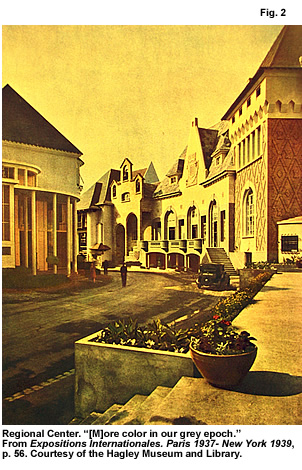
Charles-Brun's theme of "Unity through Diversity" found "perfect" and "seductive" expression in the artisan practices and products displayed at the Exposition's Labor and Regional Centers. These highlighted the advantages regional economies offered the French national economy:
Customs differ, even languages are dissimilar, but the spirit of the people is united. This will be seen by the fact that art, science, and crafts are all progressing in the same general line in different regions. That is to say, though widely separated by localities, manners, and languages, the people of France are one when it is a question of Progress." (Exposition Paris 1937: 4).
The administrative director of the Exposition's regional committee further declared, "with each regional pavilion, the Regional Center will be "like a Little France" ("comme une Petite France") produced directly by the regions and remaining under regional control." 4 In the same vein, the Exposition's general commissioner, Edmond Labbé, asserted that "[E]ach region has a soul that seeks expression through numerous chefs-d'oeuvres and thereby introduces a suppleness, variety, and warmth into modern art that cannot be had through reason or good taste alone … (quoted in Livre d'Or Officiel, 185). Much like the 1900 Paris Exposition Universelle's famed banquet of 20,777 mayors, the editors of Exposition Paris 1937 promised, "the reunion in Paris of all the Provinces will be a most interesting sight… bring[ing] together peasants from all different parts of the country—not only peasants but artists, craftsmen, [and] scientists into the Regional Center" (Chandler 1987, 39). "It will show the integral harmony of the Interior of France" (Exposition Paris 1937, 4). In a section devoted to "The Role of the French Provinces in the World's Fair," the editors also insisted that: "[t]he extraordinary medley of customs, peoples, scenery, and products which make up France will, insofar as possible, be brought to the Exposition. The Products of France are as varied as its people" (Exposition Paris 1937, 14).
The design of Exposition centers, as symbolic and material signs of French rural, folk, and regional cultures, celebrated the merits of both modernization and industrialization within a traditional French regional framework (Peer 1998; Faure 1989). Ossip Pernikoff, the Exposition's transportation and tourism attaché, noted that the 1937 Exposition was different from its predecessors in that it was not organized or built around one iconic architectural spike ("clous") such as the Eiffel Tower or the first Trocadero. Rather it revealed France through the "multiple visages" of its regions "as it really was in that year of grace." Edmond Labbé christened the entirety of the Regional Center as the Exposition's "spike" because it symbolized the union of all of France (Labbé, 1938, vol. 11: 421; vol. 8: 303; vol. 8: 307). "The Regional Center," he asserted, "was to be a microcosm of France's 27 provinces" (Labbé, 1938, vol. 8: xvi). Pernikoff further described how regional characteristics ("each following climate, race, customs … the treasures of their soul") associated with "diverse yet united terroirs" were represented by the Regional Center's 27 pavilions to achieve a "patriotic union of France" whose "individual regional traits [citing Georges Clemenceau] are so dear to the French" (Pernikoff 1938, 70, 150). L'Illustration's Raymond Lécuyer thought that the close proximity of the pavilions within the Center provided a "faithful" analog to the relation between the provinces within France (Lécuyer 1937).
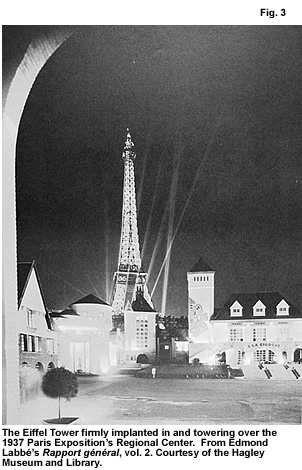
The General Committee emphasized that regionalist architecture should show "how much the benefits of experience and local art [were] not narrowly confined within the past" (Livre d'Or Officiel, 188). It wanted to give modern expression to regional potential by avoiding anything that appeared to be servile imitation and sought, instead, a free interpretation of regional character through original materials: "within and without, the architects strove to remain of their own time; to give reminiscences a fresh look, a contemporary accent" (Lécuyer). Such innovations—running the gamut from militant and unrepentant particularism to a complete convergence of national and regional interests in a generic "international style"—pointed France, it was alleged, in a new direction or third way toward "not an international style but the internationalization of [French] style" (Labbé 1938, vol. 1: 220).
If the Exposition's general architect, Jacques Greber, hoped to introduce "more color in our gray epoch," the Regional Center largely accomplished this goal (1937). Charles Bourgeois, the director of the Ecole des beaux-arts de Tourcoing touted regionalist aesthetics when he argued that "if there exists an area in which regional art achieves an incontestable value, it is clearly in architecture and its ancillary fields.… These create a style and provide the color of each regions vegetation, sky, and lighting" (Bourgeois 1938, 8). Like "freshness in a bouquet," Raymond Lécuyer found the Regional Center provided "one of the strongest attractions of the Paris Exposition." Georges-Henri Rivière also understood the Exposition's scope and grasped the Exhibition's greater pedagogical mission to provide:
1) An account of the most interesting efforts of the last 20 years;
2) An instrument of popular pedagogy, in order to place within the reach of each a documentation usually reserved to specialists, and capable of inspiring a greater desire for culture;
3) An experimental laboratory, the results of which should be capable of being adopted, so as to constitute a plan of work for the future;
4) For each country, an expression of its national characteristics (Expositions internationales, Paris 1937, New York 1939: 5).
Albert Bonnard commented on how each of the regions "stylized" its "indigenous" traditions and customs to offer crowds "an effortless and educational spectacle" Livre d'Or Officiel, 191). To this end, the 1,600 square meter Burgundian Pavilion (Bourgogne-Franche-Comté et Pays de l'Ain) located between the Avenue de Suffren and the Seine River, provided a "picturesque" composite of "traditional style and modern tendencies" in a conservative moderne vernacular (Dupays 1938, 255; Moentmann 2003, 311). "Nothing is archaic," noted l'Illustration's reporters,
[t]hat's the lesson one is to draw.… that it is possible, even desirable, to subordinate construction to the rhythms of modern life, while conserving its permanent and traditional characteristics.… Between servile plagiarism of the past and the anonymous copies of our modern decorators, is there not a renaissance that is both regional and modern? (Clouzot and Ducharte 1937)
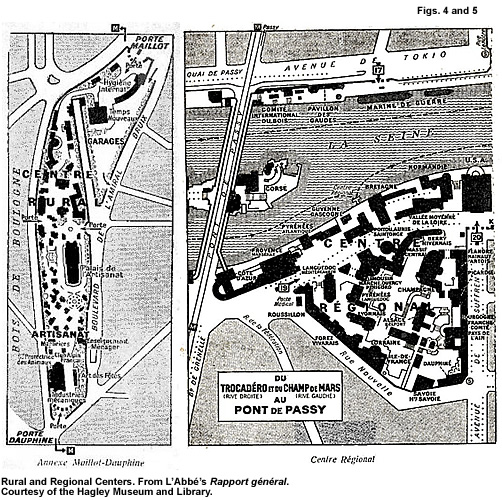
The organizers of the 1937 Paris International Exposition placed great importance in its Rural and Regional Centers (Peer 1998). Recalling the 1925 Paris Exposition's emphasis on decorative arts, the 1937 Exposition reflected the Popular Front government's investment in French technological progress and the prowess of artisan crafts. The General Committee stressed that the Regional Center would be "no bazaar– no fair– no carnival– but, instead, serve as an instructive example of France at work" (Exposition Paris 1937, 4). French national identity, it asserted, percolated through the labor and craftsmanship of artisans who "do not rest on their laurels. They go on. They achieve. Their past has given them this background. Upon that solid rock they have constructed new forms, never losing their individual ability nor their cohesion." The Exposition's General Commissioner, Edmond Labbé, wanted "to show how new methods are adapted to the respective character of each corner of the Nation" (Livre d'Or Officiel 188) and promoted artisan crafts and techniques emblematic of qualities uniquely associated with provincial France. The Exposition's General Committee believed that a crafts center, "like a small commercial city quarter lined with shops bright and gay," where "craftsmen are to be shown working as they do at usual times," would have "a particularly important position in the Exposition" simulating an experience that would allow fairgoers to "enter into the internal lives of craftsmen and artists" (Exposition Paris 1937:1).
One of the Exposition's central objectives was to illustrate how traditional building practices and contemporary personal needs could produce attractive, welcoming, and comfortable dwellings (Pernikoff 1938, 154-55). These constructions were designed to appeal to regionalists, ruralists, and others outraged by the "crimes of modern architecture," whose equal portions of air, cement, ultra-violet rays, running water, and food allegedly produced "egalitarian and nudist" cubicles devoid of local color, charm, and character (Hubert-Fillay 1937, 2-3).
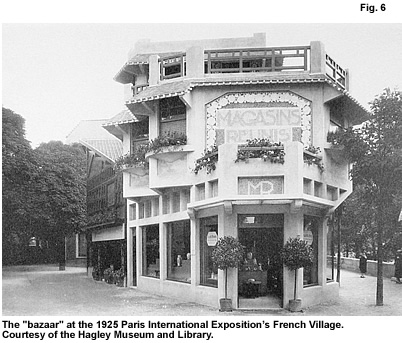
Similar concerns had previously been voiced about the architecture and interior design of the rural French Village built for the 1925 Paris Exposition. Writing for l'Illustration, Léandre Vaillot thought the designers had confused the "French village" as product of "a slow elaboration, with each generation carefully making its contribution to the previous generation's edifice" with a modern "garden city," a rapid work born out of new economic circumstances like the building of a factory" (1925, 131). Vaillot thought the former was an authentic expression of peasant culture which "belong[ed] to the inhabitants of a place" and unproblematically represented "a regional aspect [and] local physiology," while the latter gave, instead, "an indifferent, interchangeable appearance" that even where "picturesque […] is only a mold […] like the calculated décor of a theater" (131). Vaillot detected a "rational architectural tendency" denoted by modern lighting, extreme functionality, a clever yellow and violet color scheme, and chic balconies with "details too minute," resulting in an impressive style "more cubist than authentic," and "bad proportions" that spoiled the architectural treatment of the medical station, bakery, inn, sanitary station, express bar, pottery bazaar, artisan studios, and "luxurious stores," such as a pharmacy the author sardonically described as "making one feel like getting sick" (132). Vaillot felt that too much place had been given over to current policy than the accurate reconstruction of regional realities.
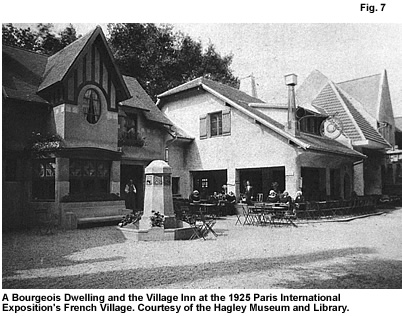
Examining the village church and cemetery designed by Jacques Droz, Vaillot detected "praiseworthy intentions" mired in an unfortunate tendency to reproduce the "artistic excesses of nineteenth-century art" (133). The furnishings of the French village's buildings, for instance, were more suitable for sedate bourgeois interiors rather than rural peasant dwellings. "One could say […] this fantasy of rich Parisians who imagine themselves living […] in an idealized rustic village […] does not indicate which village nor in which region it may be found." (133) The contiguous emplacement of buildings marked as representing different regions also confounded visitors. Side by side, the Breton and Alsatian buildings, for example, captured the Exposition's desire to stage the unity of regional France at the expense of discernible authentic regional contributions. Similarly, the village town hall (la mairie), a place to "gather, amuse oneself, [and] learn," was designed to compete with both the village church and the local cabaret by appropriating their social functions (132). Architecturally "banal and without nuance," this building aimed to provide a "peasant club" that might compete with increasing contemporary union activism (132). In addition, this utopian civic agenda also masked any trace of rural boredom, unemployment, economic depression and underdevelopment. "More art deco than anything else," (134) the "French Village" was deemed by our critic as more fashionable than enduring.
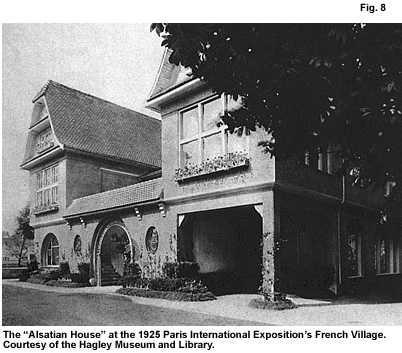
Moved by his own confidence in the merits of rural modernization, Georges Rivière easily overlooked the contradictions inherent in the elaboration of a regional architectural style simultaneously authentic and national. Touting, without evident irony, the 1937 Exposition's Rural Farm's "fine tiled pavement, partly covered with thick and fragrant litter" and the "magnificent oxen from the Charolais and the Limousin," Rivière invited fairgoers to (1938, 54-55) "[c]ome see the home of the farm laborer," where "the cooking is done in the hearth," and observe how "progress has placed quite close an electric stove and kettle" (56). He believed in the end that the "innumerable city dwellers" who visited the Regional Center "found here again a rustic soul," while France's "innumerable peasants would have understood that it is not necessary to standardize the countryside in order to modernize it" (58). Less convinced was Raymond Badouin, the editor of the prestigious Revue of French Wine (La Revue du Vin de France) and secretary general of the Academy of French Wines. Calling the Rural Center "hokey and not very serviceable," he found it to be more suggestive than authentic. Ignoring that the material facilities of contemporary farms remained shockingly "rustic" (Segalen 1984, 186-91) and despite the addition of internal plumbing (running water), Badouin disapproved that the model farm lacked an indoor bathroom and furniture. Furthermore, the wine cellar was tragically located under the roof where damaging temperature changes would most likely occur.5 He preferred the Rural Inn (Auberge rurale) where "the public could taste a very fine selection of French wines" (Badouin 1937, 10-11). Indeed, Pascal Ory notes that many Exposition visitors preferred the Regional Center's familiar provincial markers and motifs to the Rural Center's technological implementations and generic moderne style (Ory, 609-611).
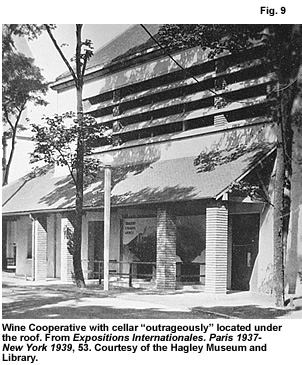
More problematic were discussions among the regionalists within the pages of Jean Charles-Brun's Action régionaliste concerning whether the Exposition's Rural and Regional Centers could ever be more than "regional masquerades." 6 Against laments concerning the Exposition's shelved plans for more extensive folk festivals and "caravan" sorties into the provinces or allegations that the Exposition's regional restaurants only competed with their genuine counterparts in the provinces and the fears that folk singers and dancers visiting Paris might acquire "regrettable ideas of grandeur", Paul Hauet asserted—while agreeing that it was "always more desirable to visit a regional museum over the regional wing of a museum … to eat a bouillabaisse in Marseilles … [or] attend an Arlesian festival in Arles rather than at the Grand Palais—that the Exposition's new centers and museums would provide the basis for genuine interest and renewed research into regional issues and agendas (Hauet 4). A contributor to Dijon's Le Bien Public attempted to resolve this contradiction syllogistically when he observed that if "France is a country of diversity," and "unity is not uniformity," therefore "uniformity is nothing more than a gross forgery" (Belloni, 6). Proud of their folk traditions, the quality of their artisanal wares, confident in their marketing prowess, and already invested in the organization and construction of the Burgundian Pavilion at the 1937 Paris Exposition, Burgundians contributed little to this discussion.
Staging Burgundian Terroir in Paris
It is appropriate to remind visitors—or to reveal to them—that, by the riches of its soil and the glory of its wines, Burgundy is one of the classic fiefdoms of French cuisine.
–Edmond Labbé, "La Participation Régionales," Rapport général (1938), vol. 8, 317.
There are two ways of traveling; that of Philèas Fogg and that of Xavier de Maistre. So, without leaving Paris, it is possible to visit the vineyards of France. Happy traveler—you need only visit the Exposition [1937].
–Paul-Emile Cadilhac, "Voyages à travers les vignes de France," L'Illustration 2 Oct. 1937.
Regional folk models remained popular for promoting economic interests through the 1930s. "Can anyone," asked Ossip Pernikoff, "speak of this region without invoking the wines whose universal reputation has made Burgundy known across the four corners of the world?" (Pernikoff 1938, 79). Albert Noirot related how vintners from the Franche-Comté were organizing "to give Burgundy the place it justly deserve[d]" at the Paris Exposition. He added that the exposition would provide a fine opportunity to demonstrate the merits of Burgundian gastronomy and wines to "millions and millions" of visitors and that it was time to organize a local committee to ensure "the success of this colossal work" (Noirot 1936, 7). "Hasn't gastronomy," exclaimed Raymond Lécuyer, "become one of the richest fleurons in France's tourism crown?" (Lécuyer).
Burgundy's centrality to French viticulture was legendary and incontestable. Indeed, one of the French National Lottery's themes was the "Wines of France" (Tranche du Vin) series. Its September 1938 drawing was held and filmed in Beaune. It was followed by a banquet with the Knights of Wine Tasting at Beaune's Caveau Nuiton. Responding to increasing demand and limited space, the highly popular festivities of the original Caveau Nuiton were relocated to the Clos de Vougeot's celebrated Cistercian cellar:
[t]he success of our cellars grows daily. People like to come not only from France but from abroad as well! That is why, despite its size, the vast cellar cannot accommodate all the gastronomes who come ("Une conférence … des Chevaliers du Tastevin":4)
Whereas they had been 200 in 1936, some 500 knights gathered to consume 1,000 bottles of Burgundian vintages in one evening in 1938.7 In attendance, the poet Max Cappe recognized the event's ability to draw national and international attention to "the virtues and incessant labors of Burgundy" (Cappe 1938, 226). On the heels of such success, the Burgundian Order of the Knights of the Wine Cups, along with their accompanying choristers, the Cadets of Burgundy, were invited to participate in the 1937 Exposition's Burgundian Days (October 25 and 26). These ended with a "brilliant soirée" in the "Wine Pavilion" where, in addition to Exposition officials, celebrated gastronomes including Gaston Dérys and the self-styled Curnonsky, Prince of Gastronomes, and other leading citizens (all told, 350 from Paris and the regions) such as Edmond Chaix, president of the Touring Club de France, participated in what one journalist called a "magnificent instrument of Burgundian propaganda" (J. T. 1937, 1). Even Jacques Copeau returned to Paris from Burgundy to stage François Porché's three-part, epic poem, "Immortal France" at the 1937 Exposition.
As early as 1931, the Automobile Club of Burgundy anticipated the role Burgundian regional culture would play at the Paris Colonial Exposition: "[t]his Fair must reproduce … something of our folklore, of our ancient customs.… Peasants and urbanites will come look, buy, and contemplate all that interests them" ("A l'Exposition Coloniale", 17). In fact, most of the prominent Burgundian civic leaders and cultural intermediaries—Gaston Gérard, Gabriel Jeanton, Gaston Roupnel, Louis Fyot, Perrin de Puycousin, Claude Chauveau, etc.—were members of 1937 International Exposition's regional committee number 13 which included the seven départements that constitute the Burgundy, Franche-Comté, and Pays de l'Ain regions (Labbé, Rapport Officiel, vol. 8, annexes, 68-70). Exposition Organizers believed visitors who discovered Burgundian gastronomy in an appropriately rustic setting would take home a powerful image (souvenir) of Burgundy's artisan, aesthetic, and folkloric riches. Mindful of tourism interests, the Exposition's administrative director also expected that they would leave imbued with a strong desire to visit Burgundy to better appreciate its charms within its original scale and setting. The Regional Center, he asserted,
is a vast laboratory where the smaller nations (pays) illustrate how to reconcile necessary traditions and contemporary techniques within the larger Nation.… [L]ike a vast symphony of French provinces.… the Regional Center is alive; it produces the image of … a dynamic France and proves that regional life remains a present reality. (Charier 1937, 1)
It should come as no surprise that the popular and commercial success of the Burgundian folkloric agenda was presented as a model of regional economic growth and cultural identity at the 1937 Paris International Exposition for Arts and Techniques. In early 1936, provincial civic, business, and economic leaders overcame intra-regional differences to coordinate their resources toward the construction of a Burgundian Pavilion that would promote the products, folklore, culture, artisanat, commerce, and industry of Burgundy, the Franche-Comté, and l'Ain (France's economic region #13 and 13½) through, most notably, "a Burgundian restaurant and cellar." 8 Georges-Henri Rivière's subsequent description of the folkloric festivities staged at the Exposition's Rural Center underscored the centrality of Burgundian elements and motifs there:
[o]n the last 23rd of August, on a beautiful evening, a gay procession was flowing down the village streets to welcome the minister of Agriculture. Under the shady trees, along the winding valleys, came the Bressan fiddlers, their instruments gay with ribbons, conducted by a fascinating old man in local costume of by-gone days. Their faces half hidden by the black lace falling from their hats, a group of beautiful laughing girls, arm in arm, marched and sang. Then came the mayor with the tri-color band across his breast, followed by peasants in their Sunday clothes. A great concourse of people was pressing forward to see the procession. The Baker, leaving his oven, appeared on the doorstep. The clanking of the milk-cart in the cooperative ceased for a moment. The lads who were changing the animals' litter came to the stable door and waved their hands at the girls. And from the terraces of the inn many customers applauded loudly. When it got to the square bordered by the school, the post office, the town hall, two steps away from the covered market, bright with people, the procession broke up whilst on a rustic platform dancing began and the wooden Bressian sabots beat the boards to the rhythm of the "rigaudins" and "chibrelis." And yet how far this was from the lands of Burgundy: in Paris, Porte Maillot, at the rural center of the Exhibition of 1937. For it was under this new scheme that the committee of Agriculture, and working together with the chambers of Agriculture and Agricultural associations, had realized its program: "to put into evidence the technical and social improvements that can be brought in "rural life" [and] to present in a manner to be appreciated, by actually tasting it, each agricultural product (Rivière 1938, 53-54).
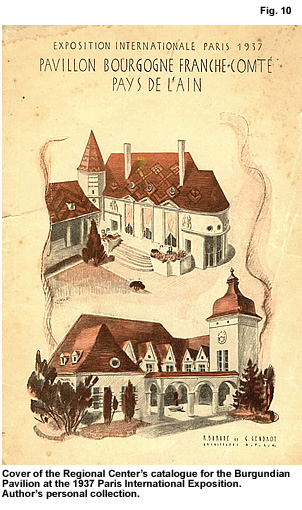
Edmond Labbé told the presidents of the Exposition's numerous regional committees, that "[t]he importance attributed to the Regional Center," stemmed from collective confidence in France as "the country of quality." He credited national "moral regeneration" and "material prosperity" whose benefit it was the Exposition purpose to showcase, to the "revitalization" of regional traditions (Labbé 1938, vol. 8: annexes, 369). Such values were invoked through exhibits that focused on the popular arts and traditions of various provinces. Museological displays of rustic Burgundian interiors for the most part copied displays found in Beaune and Dijon two decades earlier when, for instance, on the occasion of the city's annual wine action, Pierre Richard and Camille Fondet (re)furnished 19th century "Burgundian interiors" and created a "retrospective" installation on the history of wine through an "artisan work space" accompanied by "instructional" graphic panels ("Echos d'Une Journée de Fêtes: À Beaune", 4). Similar to the Paris Museum of Popular Arts and Traditions' use of wax figures to stage "traditional" folkways in their appropriate ethnographic milieux the Exposition's Regional Center's Musée de Terroir displayed Bressan milkmaids and Dijonnais vigneronnes coiffed in lacework accompanied by a mule-drawn cart and a miniature wooden train (Dupays 1938, 256-57, Pilbeam 2003). These were designed to offer "a pious asylum for historic memories of the province […] to safeguard what remains of its primitive originality, and to resuscitate what tends to disappear" (Young 2002, 173). In a time of rural depopulation and the closing of urban artisan shops, these anaesthetized effigies served to aesthetically introduce rural labor into la France moderne. The exotic vitality of France's rural workforce could in this way be presented to the electoral nation as its faithful and reliable servant. The "vigilance, fidelity, and good taste" of artisans, Gaston Gérard asserted, made them "producers of quality" (1938, 265). By showcasing high quality regional craftsmanship and stylish design, the Popular Front government, exhibition directors, and Burgundian regionalists hoped to illustrate how artisan practices anchored in particular traditional contexts (terroirs) linked modern France to the regional values necessary for both supporting the national economy and anchoring an authentic French identity.9 Visitors saw workers producing finished products in a series of workshop displays designed to give a "large and brilliant place […] to artisanry" (Lécuyer 1937).
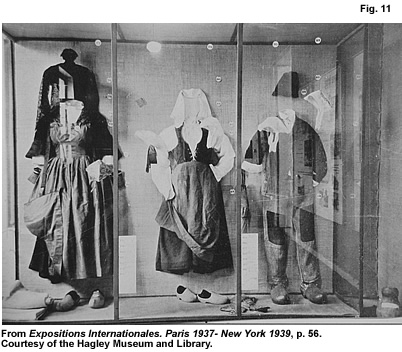
These displays reflected the influence of the ardent Burgundian regionalist and folklorist Maurice Perrin de Puycousin. He combined ethnographic ideas, museological principles, and folkloric interests by creating two museums of arts and popular traditions (Musée d'Arts et Traditions Populaires) in Tournus and Dijon. Thirty-two of his waxen images representing "a great variety of authentic costumes" from Burgundian regions had figured at the 1924 Gastronomical Fair in Dijon. Addressing a reception for the Committee for the Burgundian Pavilion, the president of the Exposition's committee directors, the 18th national economic district, and of Dijon's Chamber of Commerce, Paul Bur told his audience that he appreciated Puycousin's talent for making traditions relevant to the present (Labbé 1938, vol. 8: 303). For the 1937 Exposition, Puycousin arranged a "Burgundian Interior" and a "Weaver's Workshop" for the Regional Center's exhibit (Labbé 1938, vol. 8: 323). "Should not every village in France have such a museum?" asked Georges-Henri Rivière (Rivière 1938, 58).
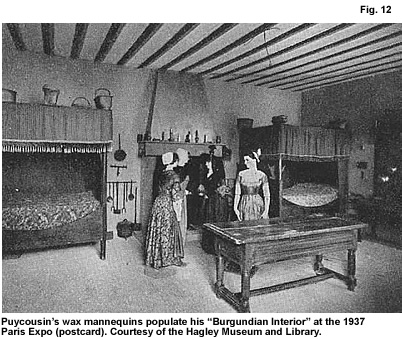
The Exposition showcased the advantages regional economic strategies and local labor practices offered the national economy. Based on the successful example of Burgundian wine festivals and gastronomical fairs developed during the 1920s and 1930s, the promotion of regional interests through folkloricized marketing strategies pioneered in the provinces proved a successful formula at the 1937 Exposition. M. Clair-Daü, the mayor of the important wine community of Marsannay-la-Côte in Burgundy, supervised the building of a 600-square-meter "Burgundian Cellar" at the Exposition Rural Center. Upon penetrating the Pavilion's main portal, visitors seeking Bacchic pleasures squeezed past a wine press "of impressive proportions" lit to create "an appropriate atmosphere" before descending "deep steps" into a capacious cellar 30 meters long and 15 meters wide. Its "powerful columns" supported an arched ceiling that covered—cathedral-like—"eight alveoli, four on either side of a central alley apportioned to reflect the importance of the different [wine] growing regions" (Labbé 1938, vol. 8: 315). The "living spirit" of each region was fetishistically displayed in the form of "venerable bottles" arranged in separate niches like religious objects and surrounded—in reliquary fashion— by decorative panels that called attention, much like the stations of a potential tourist pilgrimage, to the region's archeological sites and geographic riches (Labbé 1938, vol. 8: 315). It was there "one caressed and inhaled" a glass before "respectfully returning it to the table" (Labbé 1938, vol. 7: 331). Seated at the cellar's "rustic furniture" composed of "tables fashioned from barrels and wooden stools," visitors might imagine themselves vignerons (Labbé 1938, vol. 8: 317).
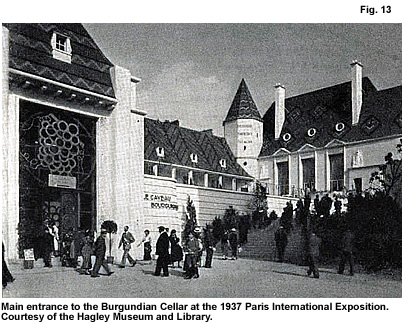
With "the famous Caveau Nuits-Saint-Georges and its Knights," l'Illustration noted, "the wine regions are particularly well represented in the Burgundian Pavilion" (Lécuyer 1937). "Only this pavilion," the Exhibition's 12-volume Rapport générale further observed, "accomplished a presentation of such importance and originality" (vol. 8: 316). To produce an "authentic cachet of terroir," the center's general architectural lines followed those of the vast cellars first created by Cistercian monks at Cluny and Clos de Vougeot (Labbé 1938, vol. 8: 316). An appropriate "atmosphere of euphoria and healthy gaiety" was achieved by mimicking the stratagems of Camille Rodier's popular caveau (cellar) in Nuits-Saint-Georges, Burgundy, where the pseudo-folkloric Order of the Knights of the Wine Cups (Chevaliers de Tastevin) convened:
From the first days, a euphoric atmosphere of healthy gaiety was established.… Beneath the beams, obscurity, barrels, rustic stools, painted murals, and drinking songs created an authentic cachet of terroir [emphasis mine] … whose thousand aromas flowed as golden and purple wines … and was represented in magnificent decorative panels executed by the students of Dijon (Labbé 1938, vol. 8: 316).
Much as in the experience of visitors to the Gastronomical Fair of Dijon's strategically located buvette-restaurant (Whalen 2007a), visitors to the Paris Exposition could taste and purchase (at "exceptional prices") any of the cellar's selected 300 different regional vintages once exposed to the appropriate "culture of wine." The Exposition's final report estimated that 150,000 glasses were served and 18,000 bottles of Burgundian varietals sold (Labbé 1938, vol. 8: 316).
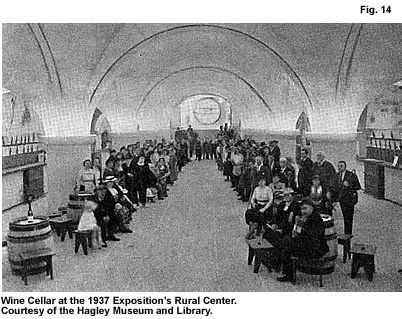
Dijon's Progrès de la Côte-d'Or reported on 13 November 1937 that the administrative director of the Exposition's regional committee, "Commander" Charier, anticipated that "with each of its regional pavilions—directly produced by the regions and remaining in regional hands—the Regional Center will be like a little France (comme une Petite France)." Staged as a living "symphony of French provinces" representing "a dynamic France and [proving] that regional life remains a present reality," the Regional Center was to be "a vast laboratory where the smaller nations (pays) illustrate how to reconcile necessary traditions and contemporary techniques within the larger Nation" (Charier, 1).
The Burgundian Pavilion designed by Roger Barade and Georges Gendrot provided a "picturesque" composite of "traditional styles and modern tendencies" in a new vernacular style (Dupays, 255). Built on a slight elevation with an inner courtyard and surrounded by a garden approach, the pavilion showcased high-quality, regional craftsmanship and design beneath a sharply sloped roof of geometrically arranged, colored and glazed flat tiles that semiotically denoted the region. The continuous lines of different architectural features harmonized facades representing Burgundian, Bressian, and Franc-Comptois regional styles. Much like the Gastronomical Fair of Dijon, the complex's entrance was marked by a Monumental Gate "of majestic proportions" decorated with "the greatest regional riches: its vines and wine" (Labbé 1938, vol. 8: 314-15). Charier hoped visitors would experience Burgundian gastronomy in the center's appropriately rustic setting, and would take home a powerful image (souvenir) of Burgundy's artisan, aesthetic and folkloric riches ("L'économie bourguignonne vue de l'Exposition" 1). Mindful of tourist interests, the administrative director also hoped visitors would leave imbued with a strong desire to discover Burgundian charms in their original scale and setting.
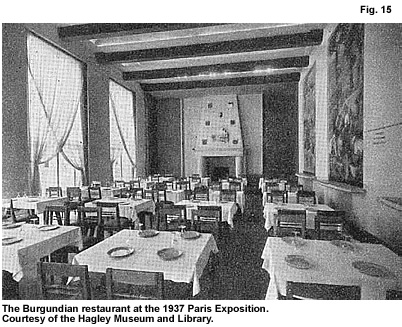
Before departing, visitors were invited to tour the Galerie du tourisme. This 28 square meter annex used the latest advertising techniques to promote tourist information. It boasted documentary films, enlarged photographs, ceiling paintings, electromagnetic wall maps, dioramas, commercial brochures, and even a library stocked "not only [with] guides and descriptive works but also imaginative works … that invoke their corner of France," and other "specialized monographs" for the "studious visitor" (Lécuyer).10 These instruments served to "glorify the well known cities, tourist attractions, thermal spas, historic sites, monuments, as well as seasonal sports" of Burgundy. Provincial arts and traditions found their greatest "consecration" in their "generously represented" cuisines. Even the Pavilions that could not set up an independent restaurant—"lest one imagine that gastronomical France can be reduced to a privileged few"—offered tasting stands filled with regional specialties (Clouzot, and Ducharte). Indeed, Raymond Lécuyer agreed that there was no better marketing strategy for the "products of the soil" than la dégustation: "[O]ne eats a lot at the Regional Center and nobody thinks to complain." Thus, in several hours, visitors could "conduct an easy and happy tour in which instruction and distraction alternate[d]" (Lécuyer).
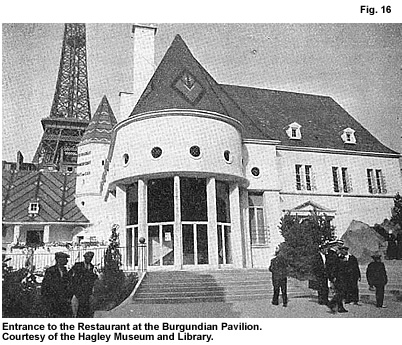
The decoration and menus of the Regional Center's 16 restaurants further underscored the ascendancy of regional over Parisian restaurateurs (Labbé 1938, vol. 7: 206). Celebrated regional chefs served "robust" regional dishes and "fine delicacies" to as many as 200 persons per dining room at one time (Ory 1998, 123; Labbé 1938, vol. 8: 317). The guided tour of the Burgundian Pavilion inevitably culminated with a visit to its restaurant where "high priests of gastronomy officiated with dignity," and waiters and waitresses "furthered the illusion … [dressed] as they still appear in those provinces that have retained their traditions" (Lécuyer). It was in this rustic-moderne dining room, under high wood-beamed ceilings and giving onto a terrace "agreeably decorated with flowers" and looking upon the adjoining pavilions of Savoy and the Dauphiné, that Burgundy's own master-chef (M. Rousseau), serving over 30,000 meals "at comparatively advantageous prices" in three months, transformed casual dinning into an act of ritual piety. He supervised a team of sous-chefs who served "succulent dishes" that included trout baked with Burgundian blue cheese, poached eggs served in a red wine sauce, creamed fish chowder (pike, monkfish, eel, and perch) with bouquet-garni, parsleyed vineyard snails, Bressian chicken in a white wine mushroom sauce, franc-comptois cheese en-croute, pike and shrimp stuffed quenelles, Corton coq-au-vin, and a cancaillotte fondue, "all punctuated by the best vintages of the terroir"(Labbé 1938, vol. 8: 318).
Decorated like the halls of contemporary gastronomical fairs and wine festivals, the restaurant's décor signaled a convergence between historic preservation and the development of regional tourism. Three colorful canvases represented the province's sub-regions (see Fig. 17). These paintings exploited a "works and days" tradition of representation to locate regional laborers and artisans as the willing, happy, and natural tenants of imagined rustic landscapes (Whalen 2007b). They gastronomically and symbolically united Burgundy around a vast brick hearth emblazoned with the crests of the province's seven most important cities (Labbé 1938, vol. 8: 318). Iconically rendered vintners illustrate how representations of rural workers—ranging from costumed two-dimensional figures in glass cases to wax effigies animating rooms of period furniture—were strategically transformed, I argue, from exotic historical caricatures into model contemporary laborers who "graciously served" in the form of appropriately dressed and reassuringly "smiling waiters and waitresses" in the Pavilion's cellar and restaurant. They served to harmonize the "disjuncture between the rhetorical aspect of tradition represented in the claim of invariance, and the continually shifting, substantive aspect, which is institutionalized in practices and texts that are reorganized and reformulated over brief spans of time without apparent forfeiture of authority" (Vlastos 1998, 4). Sated visitors then departed through a "monumental staircase" lined with resting stations decorated with artwork juried by the general commission to instill lasting images of Burgundy's enduring attributes. Thus Burgundians offered an anxious nation solace and hope.
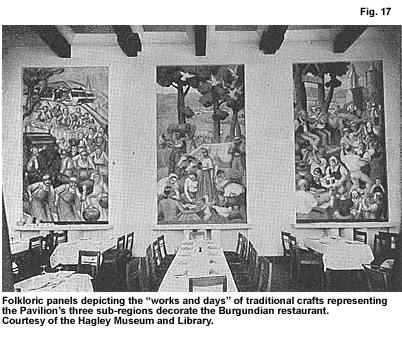
Conclusion: Republican Commercial Regionalism and French Modernization
World exhibitions are the sites of pilgrimages to the commodity fetish … They open up a phantasmagoria that people enter to be amused. The entertainment industry facilitates this by elevating people to the level of commodities. They submit to being manipulated …
–Walter Benjamin, Grandville, or World Exhibitions
While many have claimed that rural France remains the source of unchanging cultural formations and reactionary political values, my examination of the links between French folklore and economic regionalism during the Interwar period suggests that early twentieth-century French regionalism (re)defined the geography of place to associate the virtues of rural folkways with the quality of agricultural products to produce the dominant form of modern French economic regionalism. This strategy succeeded politically because it linked existing cultural interests to emerging business practices. Regional economic and cultural projects that generated civic commonality, stimulated regional economies, and promoted political unity were recognized as supporting rather than threatening a national paradigm based on universal principles, centralized politics, and modern industrial practices. The result is that French regions became the guarantors of authenticity. Indeed, republican commercial regionalism provided one of the most important and successful pathways to French modernization.
I am indebted to the Academy of Arts and Sciences of Dijon, the Archives of Dijon, and the Hagley Museum and Library in Delaware, MD for access to their archival collections, the support of their respective staffs, and permission to reproduce photographic images. I am grateful to Julian Wright, Jean-Francois Bazin, and the readers of Cultural Analysis for providing critical readings. Portions of this essay were presented at the "Staging Burgundian Terroir at the 1937 Paris International Exposition" session for the Second Interdisciplinary and International Wine Conference in Beaune on 5 November 2005 and as "The Polemics of Folk Regionalism in Interwar France," for the Society for French Historical Studies Conference at Stanford University on 18 June 2005.
1Conference proceedings were published as Travaux du premier Congrès international de Folklore, Paris, 23-28 août 1937 (Tours: Arrault et Cie, 1938). Important contemporary French folklore studies journals included: Ethnologie francaise, Arts et traditions populaires, Folklore paysan, Le Folklore vivant, Le mois d'ethnologie française, Les annales de la société d'ethnologie française, Revue de folklore français et de folklore coloniale. [ Return to the article ]
2Recently decommissioned as a National Museum, the Museum of Arts and Popular Traditions' historical role continues to generate considerable discussion questioning its political and financial engagements as a research institution. This process culminated, in 2004, with cannibalization of the Museum of Arts and Popular Traditions in the name of administrative decentralization. See the proceedings of the "Du folklore à l'ethnologie en France et en Europe, 1936-1945" conference held at the Museum of Arts and Popular Traditions last conference on March 19-21, 2003. [ Return to the article ]
3It is interesting to note that the regionalist exploitation of folklore was pitched to mass audiences in contrast to its more highbrow applications in the realms of art, music, and historical fiction. [ Return to the article ]
4Not only was the construction of the Exposition delayed by labor strikes in 1936 and 1937, but numerous divisions between central committees and regional interests hampered the construction of the Norman and Lyonnais Pavilions (Moentmann, 322-27) and lukewarm economic support in the Franche-Comté forced it to pool its resources with the Burgundian and Pays de l'Ain Pavilions. [ Return to the article ]
5The Administrative Director of the Exposition's Regional Committee acknowledged that the Pavilion was a temporary structure and wished for a more permanent Center. See M. Charier, quoted in "L'économie bourguignonne vue de l'Exposition," Progrès de la Côte-d'Or 13 November 1937, 1. [ Return to the article ]
6The Committee hosted the leaders and directors of such venerable gastronomical institutions as the Academy of Gastronomy, the International Office of Wine, the Club des Pur Cents, National Committee on Wine Marketing, the Club des Cents, and the editors of various trade magazines including La France à Table. (Badouin 1937, 8-11). Badouin was happiest among his peers attending the Committee on Gastronomy's extravaganza dinner amongst other "gastronomes." [ Return to the article ]
7Robine and Curnonsky, "Les Fêtes de Vin de Nuits-St.-Georges," Bien Public 30 March 1936, 2 and 4. "Le XXIVième Chapitre de la Confrérie des Chevaliers du Tastevin," Progrès de la Côte-d'Or 14 November 1938, 4. [ Return to the article ]
8Letter from the Exposition's Regional Committee to the Mayor of Dijon, reprinted as "Exposition International de 1937: Edification du Pavillon de la 13ième region," Progrès de la Côte d'Or 17 March 1936, 6. [ Return to the article ]
9Dijon's Socialist, Popular Front mayor, Robert Jardillier, had the three buildings of Dijon's water supply pumping station in Poncey-les-Athée conform to this architectural agenda. See Bien Public 31 October 1937, 5. [ Return to the article ]
10The Organizers of the Gastronomical Fair of Dijon staged an experimental soundproof television studio in the streets of Dijon during the first week of Novermber 1937. See, "Chronique de la Foire: La journée des P. T. T.," Progrès de la Côte-d'Or 5 November 1937, 1. [ Return to the article ]
Works Cited
1935. Une conférence&$8230; des Chevaliers du Tastevin, Bien Public. 18 November 1935.
1936. Exposition Paris 1937. No. 1 May.
1937. Exposition Internationale des Arts et Techniques appliqués à la Vie moderne. Paris: La Photolithe.
1937. Livre d'Or Officiel de l'Exposition Internationale des Arts et Techniques dans la Vie moderne. Paris: Editions SPEC.
Aghulhon, Maurice. 1982. The Republic in the Village. Cambridge, MA: Harvard University Press.
____. 1988. Histoire vagabonde, II. Paris: Gallimard.
____. 2003. Le centre et la périphérie. In Les Lieux de Mémoire, vol. 2. Edited by Pierre Nora. Paris: Gallimard.
Anderson, Benedict. 1991. Imagined Communities: Reflections on the Origin and Spread of Nationalism. New York: Verso Books.
Antoine, Annie. 1999. Terre et paysans en France aux xvii et xviii siècles. Paris: Ophrys.
A l'Exposition Coloniale, L'Automobile Club de Bourgogne November 1932: 17.
Badouin, Raymond. 1937. La Participation de la Cuisine francaise a l'Exposition de 1937. La Revue du Vin de France 124: 8-9.
Bausinger, Hermann. 1986 (1966). Toward a Critique of Folklorism. In German Volkskunde: A Decade of Theoretical Confrontation, Debate, and Reorientation 1967-1977. Edited by J. Dow and H. Lixfield. Bloomington: Indiana University Press.
Bazin, Jean-François. 1996 La mémoire du Vin; Le souvenir et l'oubli dans le vignoble bourguignon. Histoire et Sociétés Rurales 5.
____. 1977. La Bourgogne. Rennes: Éditions Ouest-France.
Bendix, Regina. 1988. Folklorism: The Challenge of a Concept. International Folklore Review 6: 5-15.
Benjamin, Walter. 1986. Paris, Capital of the Nineteenth Century, in Reflections: Essays, Aphorisms, Autobiographical Writings. New York: Schocken Books.
Belloni, G. 1937. Qu'est-ce-que le régionalisme? Bien Public 7 December 1937 quoted in Action régionaliste 37:6.
Bhabha, Homi. 1990. The Third Space. In Identity: Community, Culture, Difference. Edited by J. Rutherford. London: Lawrence and Wishart.
Bleton-Ruget, Annie. 1998. Le Front Populaire et les Composantes Agrariennes de l'Idetité National Française: Autour de l'Exposition Internationale de 1937. In Antifascisme et Nations. Edited by S. Wolikov and A. Bleton-Ruget. Dijon: Université de Dijon.
Bourdieu, Pierre. 1984. Homo academicus. Paris: Editions de Minuit.
Bourgeois, Charles. 1938. Le régionalisme et le snobisme du régionalisme. Action régionaliste 38:8.
Bronner, Simon J. 1986. American Folklore Studies: An Intellectual History. Lawrence: University Press of Kansas.
Bruno, G. (Augustine Fouillée). 1920. Le Tour de la France par deux enfants. Paris: Eugène Belin.
Buck-Morse, Susan. 1989. The Dialectics of Seeing: Walter Benjamin and the Arcades Project. Cambridge: MIT Press.
Capatti, Alberto. 1989. Le Gout du nouveau. Paris: Albin Michel.
Cappe, Max. 1938. La conferrie des Chevaliers du Tastevin. La Bourgogne d'Or September-October: 226- 231.
____. 1932. Les Chants du Terroir, Poèmes Bourguignons. Dijon: Imprimerie Lèpagnez.
Chandler, Arthur. 1987. Culmination: The Paris Exposition Universelle of 1900. World's Fairs 7:10.
Clouzot, H. and P. L. Ducharte, Le Centre Régional, Illustration August 1937, no. 4928.
Daudier, Charles. 1937. Action régionaliste 37:9.
den Boer, Pim. 1988. History as Profession, the Study of History in France, 1818-1914. Princeton, New Jersey: Princeton University Press.
Dorson, Richard. 1982. The State of Folkloristics from an American Perspective. Journal of the Folklore Institute. 19:71-105.
Duby, Georges and Armand Wallon. 1976. Histoire de la France rurale, 4 vols. Paris: Editions du Seuil.
Dupays, Paul. 1938. L'Exposition Internationale de 1937. Paris: Henri Didier.
Durand, Georges. 2003. La vigne et le vin in Les Lieux de Mémoire vol 3. Edited by Pierre Nora. Paris: Gallimard.
Echos d'Une Journée de Fêtes: À Beaune, Progrès de la Côte-d'Or 14 November 1922: 4.
Faure, Christian. 1989. Le Projet culturel de vichy; folklore et révolution nationale, 1940-1944. Lyon: Presses Universitaires de Lyon.
Febvre, Lucien. 1950 (1922). A Geographical Introduction to History. London: Routledge, Keegan and Paul.
____. 1936. Folklore et folkloristes. Notes critiques, Annales d'Histoire Sociale vol 1.
Flory, Thiébaut. 1992. Le Mouvement régionaliste francais: Sources et développements. Paris: Presses universitaires de France.
Fiske, John. 1989. Understanding Popular Culture. Boston: Unwin Hyman.
Gérard, Gaston. 1938. Artisans de chez nous, Au secours du bons sens. Paris: Fernand Sorlot.
Gerson, Stéphane. 2003. Une France locale: The Local Past in Recent French Scholarship. French Historical Studies 26.
Gildea, Robert. 1994. The Past in French History. New Haven: Yale University Press.
Goscinny, René and Albert Uderzo. 1965. Le tour de Gaule d'Astérix. Paris: Hachette.
Greber, Jacques. 1937. L'Architecture à lexposition, Illustration 29 May.
Guy, Kolleen. 2002. Rituals of Pleasure in the Land of Treasures: Wine Consumption and the Making of French Identity in the Late Nineteenth Century. In Food Nations: Selling Taste in Consumer Societies. Edited by Warren Belasco and Philip Scranton. New York: Routledge.
____. 2003a. When Champagne became French. Baltimore, MD: Johns Hopkins University Press.
____. 2003b. Terroir: Ideology and Wine, paper presented at the 2003 Society for French Historical Studies Conference in Milwaukee, IL on 4 April 2003.
Harootunian, H. D. 1998. Figuring the Folk: History, Poetics, and Rrepresentation. In Mirror of Modernity: Invented Traditions in Modern Japan. Edited by Stephen Vlasto. Berkeley: University of California Press.
Hobsbawm, Eric. 1990. Nations and nationalism since 1780. Cambridge: Cambridge University Press.
____. 1983. The Invention of Tradition. Cambridge: Cambridge University Press.
Hubert-Fillay. 1937. Architecture et régionalisme. Action régionaliste 37.9: 2-3.
Hauet, Paul. 1937. Controverses. l'Action Régionaliste 37.8:4.
Hymans, Max. 1937. Folklore et régionalsime, Action Régionaliste 37.8: 2-4.
Jameson Frederick. 1992. Reification and Utopia in Modern Culture. In Signatures of the Visible. New York: Routledge.
J. T., 1937. La Bourgogne à l'Exposition, in Progrès de la Côte-d'Or 29 October 1937: 1.
Labbé, Edmond. 1936. Ce que sera l'exposition international de Paris 1937, in Le régionalisme et l'exposition international de Paris 1937. Paris: Imprimerie Nationale.
____. 1938. Exposition internationale des arts et techniques dans la vie moderne: Rapport général. 12 vols. Paris: Imprimerie Nationale.
Lachiver, Marcel. 2002. Vins, vignes et vignerons. Paris: Fayard.
Laferté, Gilles. 2001. Le Comte Lafon: un nouvel arrivant devenu entrepreneur de la tradition bourguignonne. Cahiers de l'IHC: 41-60.
____. 2002. La Productions d'Identité Territoriales à usage commercial dans l'Entre-Guerre en Bourgogne. Cahiers d'économie et sociologie rurales 62: 66-95.
La Foire Gastronomique, Bien Public 11 November 1927, 1.
L'économie bourguignonne vue de l'Exposition, Progrès de la Côte-d'Or 13 November 1937.
Le Roy Ladurie, Emmanuel. 1974. Postface to Gaston Roupnel, Histoire de la campagne française. Paris: Plon.
____. 2001. Histoire de France des régions: la périphérie française des origines à nos jours. Paris: Editions du Seuil.
Lebovics, Herman. 1992. True France: The Wars over Cultural Identity. Ithaca, NY: Cornell University Press.
Lécuyer, Raymond. 1937. Le Centre Régional, Illustration 29 May.
Le XXIX Chapitre de la Confrérie des Chevaliers du Tastevin, Progrès de la Côte-d'Or 14 November 1938.
Mihura, Jules. 1937. Les Comités régionaux et le Régionalisme, Action régionaliste 37.10:2.
Moentmann, Elise Marie. 2003. The Search for French Identity in the Regions: National Versus Local Visions of France in the 1930s. French History 17:307-327.
Moriceau, Jean-Marc. 2002. Terres mouvantes: les campagnes françaises du féodalisme à la mondialisation, 1150-1850: essai historique. Paris: Fayard.
Müller, Bertrand. 1997. Marc Bloch et les années trente: l'historien, l'homme et l'histoire, in Pierre Deyon, et. al. eds., Marc Bloch, l'historien et la cite. Strasbourg: Presse Universitaire de Strasbourg.
Newell, Venetia J. 1987. The Adaptation of Folklore and Tradition Folklorismus. Folklore 98: 131-151.
Noirot, Albert. 1936. L'opinion d'un Vigneron bourguignon sur les Appellation d'origine. Revue du Vin de France 105: 11-12.
Ory, Pascal. 1994. La Belle Illusion: Culture et Politique sous le signed u Front Populaire, 1935-1938. Paris: Plon.
____. 1998. Le Discours gastronomique français des origines à nos jours. Paris: Gallimard.
Paxton, Robert O. 1997. French Peasant Fascism: Henri Dorgères' Greenshirts and the Crises of French Agriculture, 1929-39. New York: Oxford University Press.
Payne, Jessica M. 1998. The Politicization of Culture in Applied Folklore, Journal of Applied Folklore 35:251-277.
Peer, Shanny. 1998. France on Display: Peasants, Provincials, and Folklore in the 1937 Paris World's Fair. Albany, NY: State University of New York Press.
Pernikoff, Ossip. 1938. La France, pays du tourisme. Paris: Plon.
Pilbeam, Pamela. 2003. Madame Tussaud and the History of Waxworks. New York: Hambledon and London.
Pitte, Jean-Robert. 1983. Histoire du paysage français. Paris: Tallandier.
Poirrier Philippe. 1995. Municipalité et Culture au XXe siècle: Des Beaux-Arts à la Politique Culturelle, Thèse: Université de Bourgogne.
Revel, Jacques. 2003. La region. In Les Lieux de Mémoire, vol. 2 Pierre Nora. Paris: Gallimard.
Rivière, Georges-Henri. 1936. Les musées de folklore à l'étranger et le futur musée des arts et traditions populaires. Revue de folklore français et de folklore colonial 7: 58-71.
____. 1938. Le Centre Rurale, Expositions internationales, Paris 1937, New York 1939 Paris: Imprimerie de Vaugirard, 1938: 53-58.
Ross, Kristin. 1995. Fast Cars, Clean Bodies: Decolonization and the Reordering of French Culture. Cambridge: The MIT Press.
Roupnel, Gaston. 1929. Éloge de la cuisine familiale, Le Bien Public, 20 November.
____. 1930. Le Cru et la Marque, Le Progrès de la Côte-d'Or 3 March.
____. 1931a. Préface, in Le Clos de Vougeot, Camille Rodier. Dijon: L. Venot.
____. 1936a. La Bourgogne, types et coutumes. Paris: Editions Horizons de France.
Rozet, Georges. 1954. La Confrérie des Chevaliers du Tastevin. In Jean-André Gallat, La Côte-d'Or. Paris: Alépée.
Saintyves, Pierre. 1935. Le Folklore, sa définition et sa place dans les sciences anthropologiques. Revue de folklore francais et de folklore colonial: 29-58.
Segalen, Martine. 1984. Marie et femme dans la société paysanne. Paris: Flammarion.
Shuldiner, David. The Politics of Discourse: An Applied Folklore Perspective, Journal of Folklore Research 35: 189-201.
Stovall, Tyler. 1990. Paris in the Age of Anxiety, 1919-1939. In Anxious Visions. Edited by Sédra Stich. Berkeley: University Art Museum.
Strasser, Susan. ed. 2003. Commodifying Everything. New York: Routledge.
Vaillot, Léandre. 1925. Le Village français à lexposition. Illustration 8 August 1925: 131-135.
Varagnac, André. 1948. Civilisation traditionelle et genres de vie. Paris: Albin Michel.
Van Gennep, Arnold. 1999 (1949). Le Folklore français, Vol. 2. Paris: Robert Laffont.
Velay Vallantin, Catherine. 1999. Le congrès international de folklore de 1937, Annales HSS March/April: 481-506.
Vidal de la Blache, Paul. 1911. Les genres de vie dans la géographie humaine. Annales de Géographie 20:193-212, 289-304.
____. 1917. La renovation de la vie regional. Foi et Vie B-9 1917: 105-110.
____. 1921. Principles of Human Geography. London: Constable.
Vlastos, Stephen. 1998. Tradition: Past/Present Culture and Modern Japanese History. In Mirror of Modernity: Invented Traditions of Modern Japan. Edited by Stephen Vlastos. Berkeley: University of California Press.
Weber, Florence. 2000. Le Folklore, l'Histoire et l'Etat en France 1937-1945. Revue de synthèse 4.3-4: 453-467.
Whalen, Philip. 1999. The Identity of Burgundian Peasants and the Marketing of Regional Wines, Proceedings of the Western Society for French History: Selected Papers 27 1999: 171-181.
____. 2001a. La participation de Gaston Roupnel au procès de la Côte-de-Nuits, Hors ligne December: 6-10.
____. 2001b. Gaston Roupnel: âme paysanne et sciences humaines. Dijon: Editions Universitaires de Dijon.
____. 2006. Le Régionalisme de Gaston Roupnel, 1931-1945. In Le temps des sciences humaines. Edited by Annie Bleton-Ruget and Philippe Poirrier. Paris: Manuscrit-Université.
____.2007a.'Food palaces built of sausages (and) great ships of lamb chops.' In The Business of Tourism. Edited by J. Davidson and P. Scranton. PA: University of Penn. Press.
____.2007b. 'A merciless source of happy memories': Gaston Roupnel and the Folklore of Burgundian Terroir. Journal of Folklore Research 44: 21-40.
Wilson, James E. 1998. Terroir. Berkeley: University of California Press.
Wright, Julian. 2003. The Regionalist Movement in France, 1890-1914. Oxford: Oxford University Press.
Young, Patrick. 2002. La Vielle France as Object of Bourgeois Desire: The Touring Club de France and the French Regions, 1890-1918. In Histories of Leisure. Edited by Rudy Koshar. New York: Berg.
Zizek, Slavoj. 1989. The Sublime Object of Ideology. London: Verso.
Responses
Tradition, modernity and the regionalist Republic
a comment on Philip Whalen
At a conference in Manchester, five years ago, a colleague delivering a paper on regionalism and cultural identity in the Third Republic was asked a question by an eminent visitor from America. The question, paraphrased, was along these lines: does your discussion of regionalist cultural practices in the Third Republic not make you think, with some concern and worry, about the onset of Vichy? After all, the things of which your paper spoke seem to point inexorably to the apotheosis of conservative regionalism which that regime represents.
Philip Whalen gave parts of this paper at the annual meeting of the Society for French Historical Studies in Stanford in 2005. A similar question was asked of him, by a colleague who works on aspects of the far left and far right in the inter-war period. The answer to both questions is 'yes, but…'—and the but must be underscored heavily. For Philip Whalen's argument revolves around the notion that regionalist cultural production in the interwar years, if it had something to do with Vichy, had in fact far more to do with the development of a modern commercial economy, with populist advertising, and thus with the whole gamut of commercial advertising and popular culture that form a quintessential part of modern French agriculture and viticulture. Moreover, his article suggests, this modern agriculture and viticulture has if anything more in common with the great plans of the trente glorieuses than it does with the rather fake window-dressing which passed for regionalism under Vichy. In a tantalizing aside, Whalen suggests that popular culture of the fifties, sixties and even later has much in common with the populist regional culture his chosen subjects were purveying in the twenties and thirties. To pursue that connection would be exciting and truly innovatory, but it is naturally beyond the scope of the path-breaking project presently before us, where Whalen establishes the credentials of Burgundian regionalism, in the context of Burgundy's contribution to an important and complex cultural 'moment'—the 1937 Exposition, held in Paris.
There is, in short, a problem of perception. Regionalism has for long been seen either as a feature of right-wing fascisant discourse, full of danger for the unitarist, Jacobin values on which French republicanism is based (according to the dominant, but not necessarily correct, school of thought). Or regionalism can be seen as a less politically dangerous but nevertheless deleterious ideology, based on a loose and vague sentimentalism that, through its very looseness, undermines the more developed republican philosophical values in that same republican construct.
Philip Whalen goes some way to providing one particular angle on the attempt to deconstruct these misconceptions of regionalism. One important thrust of his argument is that the Republic—even the left-wing republic of the Popular Front—could not survive without regionalism, as regionalism had become a vital and energizing source of cultural symbolism that enabled French commerce to reach out to larger markets. Whalen also enables us to see how fruitful regionalism would become for the official political discourses of the later Third Republic, whether those discourses were right- or left-leaning. It is incontrovertible that the regionalism of the 1937 French pavilion was part of a complex attempt to promote French cultural identity; but the political aspect of this project is important as well, and the conservatism of some folklorists, well documented by Whalen, was balanced by a more pragmatic attempt to construct an authentic French product that would come to define commercial practices under the Third, Fourth and Fifth Republics. The very complexity of the different ethnological, folkloric and regionalist contributions to such important projects as the creation of the Musée des Arts et Traditions Populaires should teach us that we should always beware of over-simple political associations when examining such disciplines in the context of the 1930s.
If the 1937 exhibition showed a connection between the grass-roots regionalist movement and some of the ideas espoused by high ranking actors in the Popular Front, how were those contacts initiated, and what were the networks between State functionaries and local regionalists that allowed the French pavilion to develop in the way it did? Whalen's steady uncovering of the design and organization of the Burgundy pavilion in 1937 gives us an opportunity to understand some of the connections between regionalist activists and the public agenda of Popular Front-era politicians and administrators. The domestic problem of a divided France was at the heart of French administrators' concerns as they developed the agenda for their own pavilion in 1937. Thus the pure nostalgia of sentimental regionalists was strongly overlaid by a modern vision promoted by the politicians of the Popular Front, the result of which was the contemporary feel of the regionalist pavilions; this subtle and important connection between modernity and tradition was thus an emblematic and vital sign of a hoped-for Renaissance in French society. In many simple, mundane ways—the ongoing importance of regional identification in the food market, for example—the 1937 Exposition, with all its regionalist connotations, represents the coming to maturity of a style and vision that is with us still.
Whalen is embarking on a path which cultural histories of regionalism have only recently understood as something worth pursuing: a conclusive account of regionalism's contribution to progressive ideas about the modern republic. While the famous historian Marc Bloch—whose moral stature has had a strong influence on post-war generations of French historians—may not have had that much sympathy with the regionalist flavor of 1930s folklore studies, we need not be so chary. The regionalist aspect of 1930s folklore did not necessarily lead to backward-looking ideals, but were rather signs of the slippery, pliable nature of folklore's contribution to the discussions about French cultural identity; regionalism allowed these discussions to embrace nostalgia and modernity simultaneously.
We need, Whalen seems to suggest, to put the progressive regionalists at the centre of the stage. This entails a certain amount of putting aside of conservative regionalism, if that is possible. Historians need to look with greater clarity at the ideas and engagement of left-wing regionalists—but who are they, and how can we put their contributions more firmly at the centre of the stage? Part of this must surely involve a developing understanding of the political theories of republican regionalism. It seems logical that if we want to argue convincingly against the mis-association of regionalism with Vichy, a certain amount of political history must be necessary. Whalen points the way with his excellent contextualization of the debate at the beginning of his article. Pursuing this revision of regionalism enables a broader chronological frame of reference. As Whalen hints in his article, there were important connections between left-wing regionalism in the 1930s and left-wing regionalism in the 1960s or indeed the 1990s. It would be fascinating to be able to see Whalen's subtle understanding of folklore as a discipline full of 'vitality and creativity' applied more generally, to the connection between republican politics and the regionalist movement; in other words, to see pre-war regionalism as brimming with ideas which did in fact come to fruition, not in the early 1940s, but little by little in subsequent, republican decades.
Beneath these further questions lies one great problem. It has been difficult to make the wider connections for which I have appealed, because there are certain basic assumptions about Third Republic politics that continue to prevail. The cultural history which has helped us to engage so intimately with projects such as those outlined by Whalen has not had as a primary concern the close investigation of mainstream political actors and their ideas. Thus we are now in a position to say far more about the ideas of (for example) the folklore movement of the 1930s than we are about many important politicians of the period. This situation is changing, partly due to a recent resurgence in political history in France, where a number of doctoral dissertations have been successfully published in recent years, on subjects such as the moderate and centre-right parties who often had close connections to regionalist ideology. The full possibilities of this work will only be savored, however, once connections are re-opened between such political history and cultural historians, whose analysis of the movements that designed and recreated an image of French national identity at a time of political tension and divergence has proceeded all too often in ignorance of the precise political machinations that were in fact taking place during this period. It is difficult for a historian who would want to find out about those politicians who most favored the cultural projects of the regionalists; we simply have not had enough primary research on middle-ranking figures, whose networks of influence would most closely have overlapped, for example, with the designers of the 1937 Exposition. This situation is changing now, and the next step must be for a convergence between the political and cultural historians of 1930s France as we seek to understand this period better. This is particularly necessary for historians who are interested in regionalism; for, as well as promoting cultural identity, regionalism in France was also concerned with political questions, notably the redefinition of the republican State. There were regionalist-folklorists; but there were also regionalist-political theorists; and historians of regionalism need to know about both.
We are now talking about issues that have to do with the direction in which French history is moving. Can the political history of the Third Republic and the dominant school of cultural history work more closely together? It is greatly to the credit of Philip Whalen that this important article raises such vital and wide-ranging issues.
That French wine production is today in crisis as a result of the growing competition from New World wines and the general worldwide trend towards higher quality wines at lower prices is beyond doubt. The French system of Appellations d'Origine Contrôlées (AOC) and its rooted notion of terroir, discussed in Whalen's article in the context of the 1930s has nevertheless protected part of the industry from its effects and from the impact of the dramatic decline in internal French consumption of vins ordinaires (ordinary wines) since the 1950s. It could therefore be argued that the AOC system and the attached notion of terroir and regionalism have been played as an effective trump card by French producers and political leaders.
In his stimulating case-study of twentieth-century Burgundy, Whalen rightly directs our attention to the complex process by which competing notions of 'True France'—incarnated by terroir, tradition and authenticity and represented through the work of regionalists, civic leaders and cultural intermediaries—have provided an important pathway to French modernization. Wine production in France has benefited from the combination of regionalism and economic modernization by a carefully orchestrated marketing strategy built on the iconic, museographic and folkloric figure of the vigneron as the paragon of quality and of terroir, accompanied by hierarchization of French landscapes and regions illustrating the inherent qualities of a 'terroir béni des Dieux' (terroir blessed by God).
Following in the footsteps of a new generation of American scholars of France and of French scholars of regional folklore, Whalen offers a more balanced and complex interpretation arguing that regionalism had the ability to develop novel and enticing strategies calculated to preserve existing rural traditions and to re(invent) their ideological underpinnings. By examining Burgundy and its mise en scène at the 1937 Paris International Exhibition, Whalen questions the relationship established between folklore studies, the university and the economic framework developed to resist modernization. In the light of my own work on contemporary French national identity and wine consumption in the twenty-first century, some of the representations he has underlined from the earlier period have a continuing resonance, albeit with a different content and configuration. As a French anthropologist who has written on wine-growing culture in Burgundy, I have only a few reflections to make about this stimulating and pioneering article, suggesting a few areas for further investigation.
Foremost amongst these is the importance of an intellectual dialogue between various branches of the humanities and the social sciences and scholars from both sides of the Atlantic. Whalen himself works as an historian using family archives and ethnographic research combined with a great familiarity and passion for the region, which can be felt throughout his article. The dialogue between history, geography, literature and folklore in specific historical contexts offers a fruitful vantage point from which to question the changing nature of French cultural and national identity. In 1938, a regional museum dedicated to the wines of Burgundy was opened in Beaune by Roger Duchet, the mayor of the town who was later sympathetic to the Vichy government of Petain. The project was led by the Parisian Georges Henri Rivière. Its original display presented the pre-phylloxeric techniques and cultures of the 'vignerons', artisans and workers and was based on the fieldwork and the collection of objects directed by the folklorist and ethnographer André Lagrange, author of the novel 'Moi je suis vigneron'. The scenography was similar to that described by Whalen for the exposition internationale: 'These displays reflected the influence of the ardent Burgundian regionalist and folklorist Maurice Perrin de Puycousin. He combined ethnographic ideas, museological principles, and folkloric interests by creating two museums of arts and popular traditions (Musée d'Arts et Traditions Populaires) in Tournus and Dijon'. Neither the propriétaires-viticulteurs nor the négociants (wine merchants) were represented in this modern Burgundian rustic idyll. The rhetoric was indeed part of a regionalist construction orchestrated from Paris via the region and vice versa, but its purpose was above all to dissolve social tensions at a time of economic crisis and to give a more prominent voice to the world of vignerons (defined as workers of the land) at a time of major reorganisation of wine production and battles over the recognition of plots of land through the AOC system. The heritagization of a disappearing world was a deliberate attempt to maintain social unity in a climate of class tensions and economic difficulty. This was also a period of major negotiations about the recognition of specific plots of land under the AOC system and, by the same token, a major redefinition at an economic level of the concept of terroir as a hierarchical device. As Elise Marie Moentmann has shown, at the Paris exhibition of 1937 some regions, notably Burgundy, presented themselves in a backward looking fashion, emphasising the folklore of artisans despite a background discourse of modernization, whereas others were already stressing the role of modernity. At both a national and a regional level, the analysis of this complex configuration raises questions about which social groups were involved and to what extent their access to this vision of themselves was culturally mediated by economic and social elites. Parallels could be drawn today with the political and museographic shift from 'rurals' to 'immigrants' presented as the new 'others'.
These representations have also to be questioned in the light of current research on the establishment of AOC, which suggests that negotiations and social spheres of influence played a major part in some regions (Demossier, Jacquet, Guy). My own research argues that AOC recognition and vigneron collective identification were connected to issues of social hierarchization, ties to the land, local political power and family history. The romantic image of the vigneron as a worker in the vines is still embedded in their contemporary identification as wine-growers, despite the fact they now employ manual workers and have left 'nature' behind. This also refers to the question of who produces and mediates those representations and how do they affect the consumers? If the cultural elites are presented as the main actors anchoring a national French identity to provincial traditions and regional economies, how are they then (re)appropriated by the concerned social groups?
Finally, when examining the concept of terroir and especially the promotion of an artisanal myth, it is important to remember that wine production was becoming increasingly mechanised and this was a period when both oenology and geology became sciences and means of instrumental rationality. The historiography of terroir offers an insight into the opposition between artisans and scientists. As the anthropologist Robert Ulin (2002, p.700) has noted, while oenological knowledge is particular to cultivating and vinifying grapes, it proceeds, like science in general, with what Habermas (1971) calls a 'cognitive interest' in controlling or domesticating nature and thus by extension the work of wine growers is seen by themselves as a social and cultural process. Geology and its recognition as a branch of the science of the soil gave scientific credibility to the classification of the wine landscape in parallel with their historical and commercial recognition and, thus, the hierarchization of wines. In a similar vein, oenology which at the end of the nineteenth century was emerging as a new means of controlling the quality of wines and of fighting fraud played a major part in the construction and definition of terroir. Ulysse Gayon formed successive generations of oenologists in Bordeaux and under the influence of Emile Peynaud, and oenology progressively became the scientific basis of wine-tasting during the 1970s. The artisanal theme, however, is still presented today as a symbolic value despite the intense commodification of wine and the modernization of the wine industry. Thus concepts of terroir, authenticity and tradition reveal social cleavages and strategies adopted by various actors to combat the growing standardisation of wine as a product. It is now time to follow Whalen's critical approach by reassessing these cultural productions which provide contemporaries with space(s) useful for understanding and renegotiating the political tensions and cultural contradictions that arise at times of economic modernisation or crisis. Whalen's argument offers another opening into the debate on folklore in the 1930s and has many resonances with the role of ethnology in French society today.
Works Cited
Demossier, Marion and Jacobi, Daniel. 1994. La bouteille de Bourgogne, entre recherche et esthétique. La Revue, Musée des Arts et Métiers 7: 24-30.
Demossier, Marion. 1999. Hommes et Vins, une anthropologie du vignoble bourguignon. Dijon: Editions universitaires de Dijon.
Jacquet, Olivier. 2005. De la Bourgogne à l'international: construction et promotion des norms d'appellation d'origine ou l'influence des synidicats professionnels locaux. Anthropology of Food 3 http://aof.revues.org/document286.html. Last accessed 25, January, 2008.
Moentmann, Elise Marie. 2003. The Search for French identity in the Region: National versus Local visions of France in the 1930s. French History 17: 307-327.
Ulin, Robert C. 2002. Work as cultural production: labour and self-identity among southwest French wine-growers. Journal of the Royal Anthropological Institute (Man) 8: 691-712.